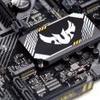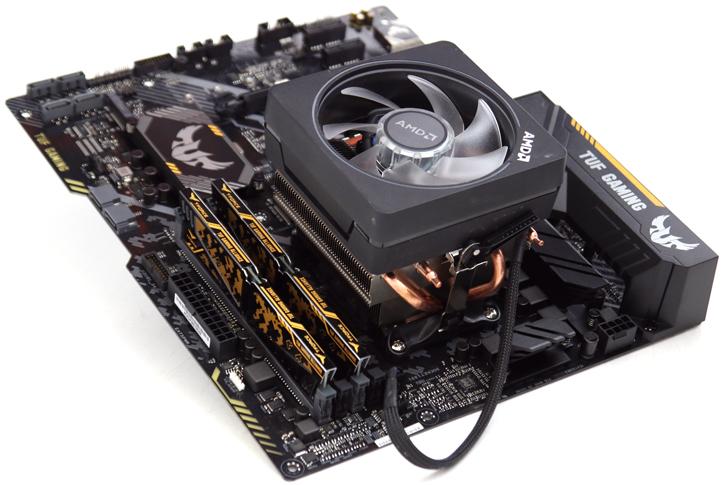Conclusion
Final Words
The new TUF is a viable alternative in a more affordable segment. With the right kit, it actually looks quite nice. Especially the memory we've been able to use eh? That said, the board performs a tiny bit slower than the competition and has been dumbed down in quality. You get six power phases, a Realtek 887 based audio solution (as opposed to 1220), and Realtek Gigabit as opposed to Intel or Killer. So features and perf wise, it's all a bit dulled down, so brand preference will be a thing with your purchasing preferences. There is no AC WIFI either. Other than that you get M.2 performance on one slot, the second is slower but sure that's ok. Here also no heatsinks. My biggest problem, however, is that the board has two physical x16 slots, the first properly configured at x16 Gen 3.0 linked directly to the processor. The second, however, isn't linked to the processor, for some weird reason ASUS figured it would be good to link it to the chipset, and that means an x4 Lane configuration at PCIe Gen 2.0. I don't get as to what that decision was made as X470 is about bringing SLI and Crossfire compatibility, that indeed is a no-go on this board. This board easily could have had two x16 slots configured at x8/x8 and then the third one at x4. Other than that you'll get your six SATA3 slots, however, four of them are facing upwards.
The motherboard
ASUS offers decent perf with this X470 series motherboard, it, however, was the more 'slower' one among the X470 boards we've tested. This is trivial though, as you are looking into very tiny margins. It functions well and offers decent enough feature set. Please make sure that you flash the latest firmware to this new platform. At €159 we did expect a bit more though. We did not run into stuff that worried us though. The motherboard used seems pretty well tuned, we had no stability issues. We tried 3200 and 3400 MHz kits we have, all work fine. Tweaking wise, the motherboards will not be any limitation, not from any brand as the Zen+ processor all will reach that 4.2~4.3 Ghz domain. Be warned though, tweaking has been limited more with the BIOS for this board, you cannot force a voltage on the CPU, but can apply an offset.
Gaming performance
Previous Ryzen reviews have taught me that it is extremely hard to convince a big part of the guru3d community and reader base that Ryzen is plenty fast for gaming. The new Zen+ processors and the respective platform overall bring a bit more oomph compared to last year's Ryzen. The fact remains, that if you take a Core i7 8700K it will still beat Ryzen in CPU bound gaming situations (low resolutions or extremely high refresh rate where a game is not GPU bound). The difference and gap towards Intel are getting smaller though. Get yourself a nice G.Skill FlareX memory kit at 3200 MHz and you've covered your gaming bases. Keep in mind that a CPU bottleneck has always been far less important compared to a GPU bottleneck, which is why I'll keep saying it, that differential is trivial at best. Honestly, with the money you save on this processor compared directly to the cheapest eight-core Intel processor you can find, you probably should invest in a faster graphics cards.
|
Ryzen |
Cores |
Threads |
Base/Boost |
Cache |
TDP |
COOLER |
SEP (USD) |
|
Ryzen 7 2700X |
8 |
16 |
4.3/3.7 |
20MB |
105W |
Wraith Prism (LED) |
$329 |
|
Ryzen 7 2700 |
8 |
16 |
4.1/3.2 |
20MB |
65W |
Wraith Spire (LED) |
$299 |
|
Ryzen 5 2600X |
6 |
12 |
4.2/3.6 |
19MB |
95W |
Wraith Spire |
$229 |
|
Ryzen 5 2600 |
6 |
12 |
3.9/3.4 |
19MB |
65W |
Wraith Stealth |
$199 |
DDR4 Memory
The latest firmware for both the older 300 chipsets series and the new 400 Chipset series including the X470 have matured and is an accumulation of DDR4 memory support that evolved when the original Ryzen series was released. Memory compatibility should not and likely will not be an issue as long as you stick to recently released DIMMs. I'll keep repeating this, but there are some really good Ryzen optimized kits out there. The G.Skill Flare X series at 3200 MHz CL14 is hitting a nice sweet-spot and is 100% stable + optimized for your Ryzen infrastructure. We also tested the new Ryzen Sniper X optimized kit from G.Skill, it runs 3400 MHz straight out of the box and will bring your memory bandwidth in the 50K rangers. However, take my advice: Flare X at 3200 MHz CL14. Install it, activate the profile in the BIOS, restart ... and never look back.
Energy efficiency
With The 2700X processor now fabbed at 12nm TDP now has risen towards 105 Watts, that is a bit steep. Realistically, does anyone really care? I doubt it. A full PC at idle will sit in the 50 Watt range with a dedicated graphics card installed (GeForce GTX 1080 / 16 GB memory / SSD and the motherboard). When we stressed the processors with a Prime 1024M run we reached roughly 166 Watts. A threaded CB15 run, however, reveals close to 200 Watts of power consumption (for the entire PC). That certainly is on the high side. When we game we hover at 270~280 Watts, but obviously that factor is dependent on the type of game and graphics card you use of course. So yeah, it's all a notch higher with the 2700X for sure, it's up to you whether or not this is a relevant thing for your purchasing choices. Remember, this is a fully locked & loaded eight-core and 16-threads processor.
The conclusion
I think the TUF X470 looks nice enough for what it needs to be. You need to like the yellow/black color schema of course. Performance wise, while not the fastest kid on the block, it really didn't disappoint either. I do feel that ASUS cut away too much in this board, with just one full x16 Gen 3.0 slot available and that second one really only offering x4 lanes at Gen 2.0, that's a no-no for me. I don't care if you go the Multi-GPU route or not, but X470 was designed specifically to offer that. Also not even one heatsink shield for your M2 storage unit, a more simply Realtek 887 audio solution, no WIFI, and a somewhat cheaper Realtek Gigabit Jack is what you get. In retrospect, we feel that the board at 159 EURO/USD still is too expensive, as this is slowly looking to be like something that B450 would offer? Tweaking wise things have been dumbed down a bit in the BIOS. All you need though is a bit of a voltage offset and you'll reach an all core 4200 MHz easily, but here again ... you get 6 phases only. As our thermal image shows, it doesn't overheat though, something closely the VRM area certainly was running very hot which in term could heat up surrounding components. The BIOS itself is user-friendly and offers pretty much all you'll need. ASUS offers a nice looking board that is Aura LED configurable and also includes some nice AURA RGB effects. In the end, though, it's reasonably nice performing product, but too much was cut away compared to sub 150 EUR offerings from Gigabyte and ASRock. Spending money on an X470 chipset and then getting just one usable x16 slot is not what the chipset is designed for, with its 6 power phases you might as well go for a B450 really. In the end, it's a nice looking board which at 139,- perhaps would have made sense, but at 159 EUR/USD, it just doesn't deliver as expected.
- Sign up to receive a notice when we publish a new article
- Or go back to Guru3D's front page.
“A mind needs books as a sword needs a whetstone if it is to keep its edge.”


